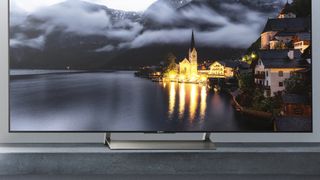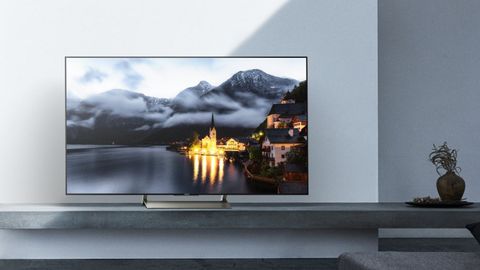TechRadar Verdict
Despite not boasting Sony’s top-tier video processing system, the 65X900E’s successful combination of an unusual direct lighting system with Triluminos colour technology and an eye-catchingly affordable price makes it something of a mid-range hero.
Pros
- +
Strong HDR Pictures
- +
Good value
- +
Gorgeous SDR pictures
- +
Attractive design
Cons
- -
It could be brighter
- -
Very limited viewing angle
- -
Android TV can irritate
- -
No Dolby Vision support
Why you can trust TechRadar
Sony’s 2017 TV range is turning into a procession of evidence that the brand is listening to its customers more than any other TV brand right now.
The recently tested A1E OLED models finally satisfied the Sony fan itch for a big-screen Sony OLED TV. The 55X930E delivered most of the brightness and backlight blooming improvements to Sony’s Slim Backlight Drive technology we’d hoped for. And now we have the 65X900E, which not only recognizes the widely held view that LCD TVs with direct lighting handle high dynamic range pictures better than the more common edge-lit variation, but also makes its direct lighting system available for an unusually affordable price.
Design
While the 65-inch 65X900E feels noticeably more plasticky than Sony’s X930E and, especially, A1E OLED TVs while you’re setting it on its centrally mounted stand, from a distance it actually looks like a pretty premium TV.
The screen looks glossy and is mounted within a strikingly narrow black frame, while the desktop stand enjoys a handsomely gleaming metallic finish. This stand’s two connection ‘struts’ also thoughtfully contain a handy cable management system, so dangling wires don’t have to detract from the minimalistic elegance.

Connections are plentiful despite the 65X900E’s relatively affordable price. A quartet of HDMIs all support 4K and HDR sources and three USBs, while the network features can be accessed via integrated Wi-Fi or an Ethernet port.
Screen sizes available: 49-inch, 55-inch, 65-inch, 75-inch | 4K: Yes | HDR: Yes (HDR10, HLG) | Panel technology: Direct-lit LCD with local dimming | Smart TV: Yes, Android TV | Curved: No | Dimensions: 1447 x 830 x 60mm (W x H x D) | 3D: No | Inputs: Four HDMIs, three USBs, RF input, optical digital audio output, integrated Wi-Fi

Smart TV (Android TV)
Rather than using a proprietary TV smart system like Samsung, LG and Panasonic do, Sony’s smart TVs import Google’s Android TV.
While Android TV has improved substantially over the past two years, it continues to frustrate as much as it impresses. Its interface feels overbearing and dictatorial, there aren’t enough options for customizing its presentation, and it still doesn’t seem to understand that the needs and app preferences of typical TV users are quite different to those of mobile phone users.
It’s worth adding that the 65X900E’s Netflix and Amazon apps both support 4K and industry standard high dynamic range streams. Since the 65X900E uses Sony’s X1 chip rather than the more powerful X1 Extreme chip, though, there’s no support for the premium Dolby Vision HDR platform that’s due to be added to Sony’s X930E, A1E and Z9D TVs later this year.
HD/SDR Performance
The 65X900E excels with HD and SDR content. HD benefits from Sony’s X-Reality Pro HD-to-4K upscaling system, which compares incoming HD content against a built-in database of video scenarios to introduce hugely impressive amounts of extra detail and color finesse.
Sony 4K TVs that carry the more powerful X1 Extreme processing engine (which uses a dual database upscaling system) manage to look even sharper and cleaner with HD sources. But the 65X900E’s HD upscaling is as good as it gets for its price point.
Overall, HD/SDR content looks good. Contrast looks gorgeous, with zero backlight clouding or grayness if you use the Cinema Pro picture preset. There’s an outstanding amount of shadow detail in dark areas too, and colors look natural and full of subtle tones. Really the only issue with SDR playback is that you can start to see some quite pronounced blooming around bright objects if you watch the screen from an angle of more than around 25 degrees.

4K/HDR Performance
Sony has consistently proved hard to beat when it comes to unlocking the potential of all those pixels that make up a 4K screen, and the 65X900E keeps the good times rolling. Ultra HD Blu-rays and 4K streams look superbly crisp and detailed thanks to a combination of unusually subtle color management (courtesy of Sony’s ever-dependable Triluminos engine), excellent light control for an LCD TV, and the best motion processing in the TV world.
That said, it’s obvious right away that the X900E's direct-lit LCD images are nowhere near as bright as those of Sony’s XE9305 and ZD9 step-up LCD models - an impression confirmed by measurements that show the 65X900E only hitting around 850 nits of brightness when showing a white HDR block that takes up 10% of the screen. (The 55XE9305, by comparison, punched out around 1450 nits using the same test signal.)
This is a big deal for HDR, which needs brightness to deliver its brightest light peaks, more color volume from HDR sources. While the 65X900E might not deliver on HDR’s full potential quite so dramatically as its more expensive sibling range, its brightness is still higher than that of many rival TVs in the same sort of price range - as well as all OLED TVs we’ve seen so far.

In an ideal world the 65X900E would provide a few more individual local dimming zones to reduce the extent of the backlight halos. But even as things stand the 65X900E delivers a more immersive and consistent HDR experience than most if not all edge-lit rivals - something that will appeal more to some if not many movie-loving AV fans than the more spectacular HDR gymnastics of edge-lit stars like the Sony 55XE9305 and Samsung QE65Q9F.
The 65X900E’s main HDR weakness is actually its viewing angle. Watching HDR from much of an angle sees the backlight haloing issue become dramatically more noticeable - so much so that it could be a deal breaker for rooms where family members routinely have to watch TV from a significant angle.
Sound
The 65X900E’s sound isn’t as successful as its pictures. It simply doesn’t have enough low-frequency power or depth to sound convincing with such movie staples as explosions and space ship engines, and this can also lead to treble details sounding a little over-exposed and brittle.
The speakers can even distort when the going really gets tough – though dialogue does somehow manage to always remain comprehensible and credible, and the sound creates a surprisingly large presence that extends well beyond the edges of the screen.
Other panels to ponder
If you want a more explosive HDR experience and/or a TV for a particularly bright room and you have more cash to spend, you could step up to either the Sony 65X930E or even the Samsung QE65Q9F, with its debut QLED technology. Both of these options also deliver wider color ranges than the 65X900E, but can suffer with more backlight ‘pollution’ during very high contrast sequences.
Or, if you prefer perfect blacks and wide viewing angles to brightness, LG’s B7 OLED TVs will be arriving soon offering a performance level likely to be in line with the recently reviewed OLED65E7. Though you’ll need to spend a couple of grand more than the 65X900E costs to secure the 65-inch B7.
Verdict
By cunningly offering a direct-lit, HDR-capable 4K LCD TV at a surprisingly affordable price, the 65X900E stands out from the mid-range crowd in a way that I suspect will make it very popular.
It deserves that potential success, too. For while it’s not the brightest TV on the HDR block, for anyone who can work round its limited effective viewing angles it delivers pictures that still look punchy, dynamic but above all immersive in a way that even some much more expensive TVs struggle to match.
- Don't miss our round-up of the best TVs of 2017
John has been writing about home entertainment technology for more than two decades - an especially impressive feat considering he still claims to only be 35 years old (yeah, right). In that time he’s reviewed hundreds if not thousands of TVs, projectors and speakers, and spent frankly far too long sitting by himself in a dark room.


